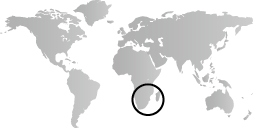Traditions of monumental stone architecture in present-day Zimbabwe are continued into the early seventeenth century in Torwa state, an apparent offshoot of the Great Zimbabwe culture. Closer to the coast, in what is today eastern Zimbabwe and central Mozambique, Mutapa state controls trade routes that link the coast to the interior. Prestige items imported from Asia and Europe, as well as locally produced cloth and precious metals, are disseminated through the Mutapa court to gain the support of client chiefdoms. On the island of Madagascar, the Maroserana dynasty, a ruling class of foreign origin, emerges in the early seventeenth century and gains control of populations and territories throughout southern and western Madagascar, forming the Menabé, Boina, and Mahafaly states. The Merina state of the central highlands, which is not under Maroserana rule, also emerges at this time. Textile and funerary arts are central to the courtly cultures of these polities. On the eastern coast of Madagascar, Arab-influenced rulers employ court scribes to compile royal histories in an Arabic script called sora-bé. In 1652, the Dutch East India Company establishes the colony of Cape Town on the Cape of Good Hope in present-day South Africa. Wealthy Dutch landholders and members of the colonial government build lavish homes here in the Dutch colonial architectural style.


